![]()
Core Idea
The migration of world population into the cities is creating unprecedented challenges for planners, governments, educators, sociologists, and business — not to mention the impact on individual lives, families, and communities of all sorts. Cities are the most complex organizational and human, relational structures — both formal and informal. They present a unique, extraordinary challenges to those wanting to serve, reach, or see their city transformed through the power of Christ. This chapter helps you explore the key issues you will face in forming networks, partnerships, or other coalitions to reach and/or serve your city. It will give you ideas and suggest practical steps to “get your arms around” one of the truly great modern ministry challenges.
![]()
Over the centuries, cities have served as trading centers, communications crossroads, centers of political and financial power, and places of safe havens where minorities could “disappear” and carve out a life for themselves. Because of their diversity and dynamic environment, cities have always been home to the best and the worst: a hotbed for innovation, crime, development of the arts and culture, clustering of technology, and political and financial power. As the diversity of cities’ communities has grown, they have become a breeding ground for ethnic ghettos, conflict, and microcosm of the world’s have and have-nots.
We Live In A New World
Melbourne, Australia is now the second largest Greek city in the world. Toronto, Amsterdam, and Fremont California are centers for diaspora Afghans. Chicago has more Poles that San Francisco has people. Vancouver, British Columbia with a large, growing Chinese community is now dubbed HongCouver by many. Los Angeles is the second largest Persian speaking city in the world. It’s a city where over 175 languages are spoken every day and where 82 different languages are used in formal education!
Washington State, 15th in population among American states, is third in linguistic diversity with over 180 languages spoken by its population!
50 million Chinese live outside of China. There are more Muslims than Jews in the U.S. And, in Brussels, the center of the new “unified Europe,” one in every four babies is Arab.
Powerful Forces Pushing and Pulling People Into Cities
Consider —
If the whole world were a village of just 100 people —
- 57 would be Asians, 21 Europeans, 14 would be from North and South America, and 8 would be African
- 70 would be non-white; 30 white
- 70 would be non-Christian; 30 Christian
- 50% of the wealth would be in the hands of 6 people all of whom would be Americans
- 70 would be unable to read
- 50 would suffer from malnutrition
- 80 would live in substandard housing
- 1 would have a full college education (7 )
Then imagine a city ten thousand times that size!! Certainly while no city reflects that kind of perfect representation of global circumstances — the brutal realities are all ever present. In some cases in even more extreme measure.
Every year Delhi, India, the capital of the world’s largest democracy, grows by the size of the city of Richmond, Virginia in the U.S. — approximately 200,000 people! When I first started visiting Karachi, Pakistan in the mid 1970s it was a comparatively quiet trading center on the Indian Ocean with a population of about 3.5 million. Today its size is up 400+% with over 14 million population made up of dozens of ethnic groups, most of whom have migrated into the city over the last 30 years. Public services have broken down, violence is rampant, and only the Pakistani Army’s presence provides a modicum of stability.
Kingdom Collaboration: A Way of Seeing Your City
- See your city in its diversity. The challenge for all of us is how do you break down the city into parts that are strategic yet of a size or complexity that can be known and understood? Maybe not immediately — but with research, love, and work you can see your city as an organic whole that has at least four dimensions (and probably hundreds of smaller, yet vitally important subdivision!):
- Geographic segments (where the people live or work– natural groupings?)
- Demographic groups (what are the age, gender, socio/political/economic, education, etc.?)
- Ethnic/language (who do they identify with, what language binds them together?)
- Function (what are the natural sectors of interest/activity such as media, labor, youth, business, education, churches, political structures, sports, etc.?)
These are the natural groupings by which we organize our lives and our relationships. They are always the categories to think and pray about when you consider how to reach and serve your city — or parts of it. Inside each of these four groups there are likely to be subgroups. And, there are groupings that may cut across several of the categories.
Some examples —
Ethnic and language background — Possibly the oldest and most predictable clustering of people in cities. Language and our culture are the heart and soul of our human experience. With migration so significant, people on the move all over the world, is it any wonder that, in an environment of change and uncertainty, we naturally gravitate to those who think and talk like we do? We want to hear our own language, eat our own food, and know what to expect and how to act when we meet with others. That’s why ghettos of all kinds have always been such a pervasive reality in cities. Today those ghettos may not necessarily mean economic hardship but, rather, simply a desire to be with “people like us.”
Geographic location — it’s an element of cities and communities that has usually been aligned with economic circumstances. How wealthy you are or are not was frequently a predictor of where you lived in the city. In a high percentage of cases that paradigm continues till today. Money provides choice. While this can be a helpful way to look at a city, times are changing. In cities where there are a growing number of people with more evident economic options (usually the middle and upper income brackets), choice is creating very mixed neighborhoods — particularly in the center of great cities. Many people choose to be near the center of the action where there is a sense of life and diversity. With choice comes independence and with independence frequently comes new structuring of communities. So, the old notion of being able to connect with people, personally, because they are part of a neighborhood or community is, in many cases, a lost dream. High rise apartments, security systems, sound proof construction means you can live alongside individuals for years and hardly know them. “Don’t bother me. I won’t bother you.” For those wanting to connect with, reach, and serve people like this with the love of Christ, these changes create new challenges for communication.
Function — what do you do or what are your special interests? Union members from the factory may bowl together. Musicians or actors may frequent the same restaurants. Business people may belong to the same clubs. In the middle ages it was the “guilds” that brought specialized trades or workmen together. Today it may be Rotary Club, women’s organizations, educational associations, or other special interest groups.
Cutting Across The Lines — means that community initiatives like United Way, or the Symphony Orchestra, or 4-H Clubs, or youth sports programs frequently bring very different people together. While these activities often reflect influences of economics, the geography of your city, or the education of the participants, increasingly there are groupings that cut across the lines and provide a meeting point for diverse members of the community.
Sadly, or naturally some might argue, our local churches usually reflect these same realities. The average suburban church has few ethnic minorities. And the immigrants — particularly first generation, quite naturally, want to hear the music and message in their own language — and to be able to interact with others that think like they do! Further, churches frequently also reflect an economic and/or educational bias with higher concentrations of “wealthy and influential” people in certain churches. While there are shining exceptions to these influences, the churches that reflect racial, economic, educational, and vocational diversity are rare. In most cases, those exceptions have been because of great, sustained vision, determined commitment, and intentional structuring of the content and style of the church’s ministry.
So what does all of this mean? Simply that no single partnership can ever hope to reach/serve these widely varying special needs/interests. This suggests that any effort at a city wide initiative will probably be best structured as a network — not a partnership. Networks exist to help individual ministries with a common vision do their own individual work better. (They often have specific partnerships associated with them that undertake specific projects.) Partnerships are where all agencies/ministries are focused on a single outcome — with each partner playing a role in that commonly agreed goal. If you’re doing something with a highly specific focus and very specific outcomes, a partnership may be fine.
Here is a diagram that may help us imagine how the various pieces might fit together.
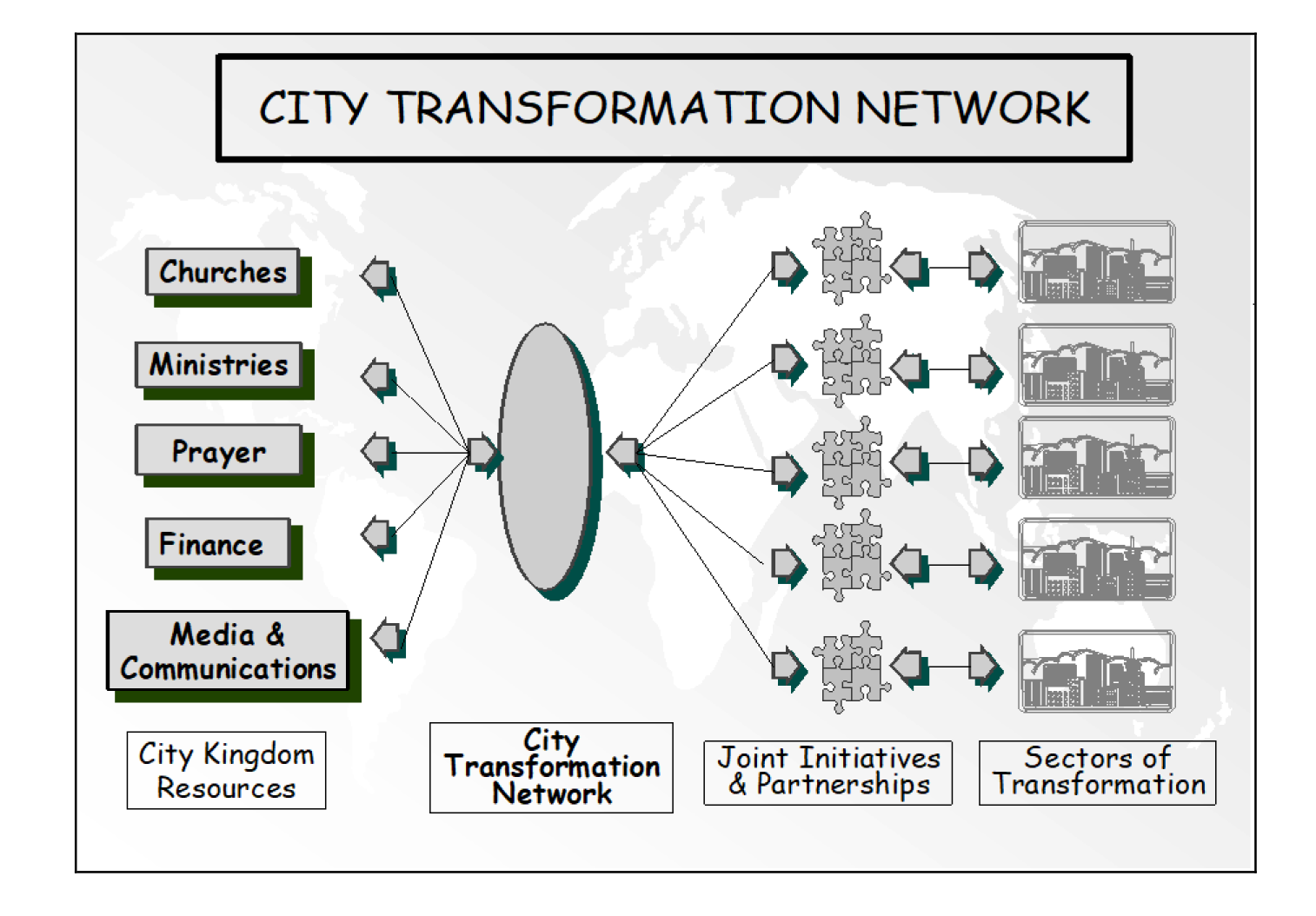
- See your city through the perspective of the Scriptural model of evangelism/ transformation. Everyone comes to Christ because of a process. Jesus repeatedly talks about sowing, watering, and reaping (John 4:35-38). The missionary, St. Paul confirms this vision of individual transformation (I Corinthians 3:1-9). Being faithful and consistent in our life and witness, realizing that it takes all of us to do His work, paves the way for fresh appreciation of the need to work together. Cities are big, complex places. At any one time there are thousands of people at these various stages of coming into the Kingdom and growing in Christ. Our city’s transformation network and partnerships can help link the elements to consistently, effectively influence these lives.
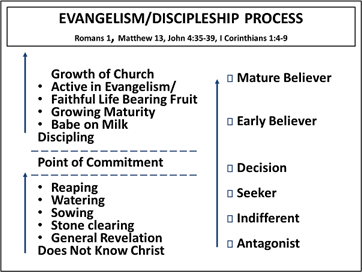
- See your city through the perspective of how decisions are made for significant change. Change, spiritual and otherwise, does not happen overnight. We need people who are committed to a faithful approach to the ‘long haul’ of coming alongside and working with individuals and communities as they move through the process of change. Working together, these different, often distinct, but all important roles, can be empower transformation of our city.
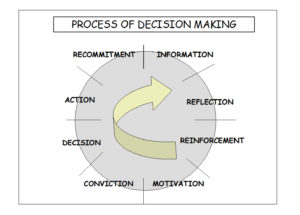
- See your city through the perspective of its many communications channels. All forms of communication are important. From private prayer and one on one over coffee to the mass media. Research makes clear they play different roles as people move through stages of resistance or antagonism through indifference to becoming ‘seekers’ and, eventually believers. When we value, respect, and link these roles the potential for transforming our city becomes much greater!
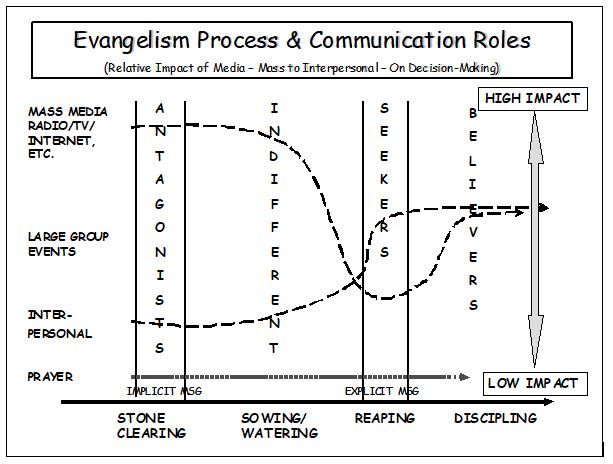
- See your city through the perspective of its many collaborative possibilities. As we discussed earlier, cities usually can be broken down into many segments; some highly visible, others less so. It is of tremendous value that people working in these various segments have a place to meet, learn from each other, share stories of progress and problems, and to be able to pray for and celebrate with each other. In short, partnership is critical. A partnership dealing with ethnic groups in your city, for example, may involve prayer networks, Christian media, local churches, youth or sports, social service ministries, those from business and marketplace ministries, and those experienced in developing local fellowships of new believers.
The diagram below suggests some of the “warp and woof” of how all these opportunities and Kingdom resources can intersect in a city transformation network.
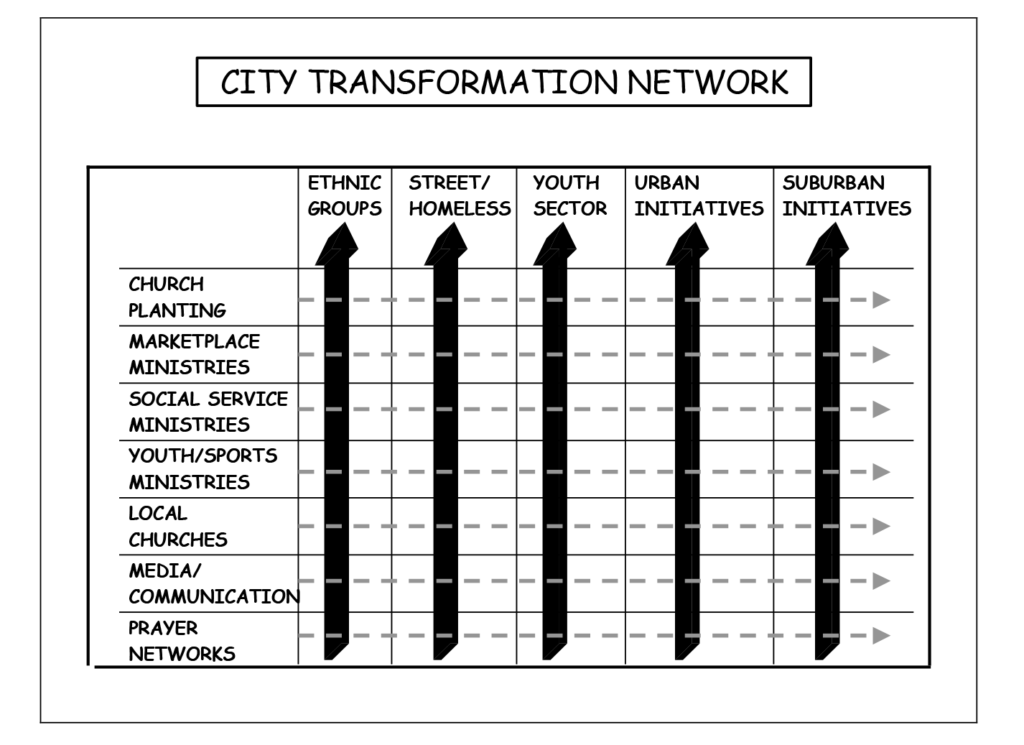
The Challenge of Choice
Any initiative that will have any real impact has to make difficult choices. As is true in every aspect of life, you can’t do everything equally well. And, even when you have made your choice, you must crawl before you can walk, then walk before you can run.
Our cities provide a diversity of ministry opportunities concentrated in a comparatively small area unchallenged by any other ministry setting. That’s why seeing your city through “eyes” like those suggested in the diagrams above is so important. The complex nature of cities means that our earlier discussions about setting limited, but high-value, achievable objectives is so important in this setting.
A Key Partnership Principle:
- There is no “one right way” for a city initiative to begin or to be organized. But the key elements discussed earlier in the book such as strong vision, deeply committed leadership/facilitation, clear, high value limited objectives, strong ownership of the process by all the players, prayer support, and practical, near term outcomes are vital.
The Challenge of How and Where You Start
So, if you have a heart for your city, where do you start?
Do you and some of your colleagues call a meeting of “influentials,” and try, from the outset, to look at the big picture of the city’s need? Does an existing, effective network of specialized ministries working in the city see the potential of wider influence and invite others to help realize the vision? Do pastors who are meeting and praying together try to turn their fellowship into tangible action? The reality is that any of those approaches may be effective — depending on the circumstances in your city or community.
You face at least two key questions: Who needs to be involved? Later on in the chapter we explore possible answers to this question in a section called The Challenge of Power and Ownership. Then, what should be the primary focus of our effort? Let’s start with the second question first.
Here is something you or you and your friends who are concerned about your city may want to ask: “If Jesus’ power was let loose, top to bottom in our city or community, how would it look different in five years?”
This question poses a tremendous challenge for modern believers because the Church, for so many years, has been substantially disconnected from the city around it. Many Christians in the local churches are active in various elements of the community’s businesses, schools, medical services, and other institutions. But the Church has rarely asked, “What is our responsibility and role in the community to demonstrate the power and love of Jesus?”
Such a question raises fundamental issues of how we see God’s grace and power affecting everyday life. It really comes down to what do we mean when we talk about “transformation?” When we look at the individuals in the Scripture who were touched by direct contact with Jesus, we see Him ready to address a wide range of human needs. Notice He never demand that, first, they had to talk about “religious” issues or use religious terms. Wholeness in people’s lives was His business. While His ministry, of course, was ultimately focused on redeeming our eternal destiny, day to day He lived out God’s vision: “I have come that you might have life and have it to its fullest.” (John 10:10) So, we ask, “What does that mean in our community or city?”
Partnership Suggestion:
Try this with your partnership facilitation team or the leadership of your local church. Next time you have a retreat or some “space” to think, talk, and pray together, meet where you have a white board, flip chart, or other means for recording your thoughts. Then, ask, “If Jesus power and love was let loose in our community, top to bottom, how do we think it might look different?” It’s another way of asking what are the elements of daily life where we think Jesus wants to make a difference? Start by brainstorming some of those categories. Each community is unique but, across communities, there are many, similar issues of need. What are the signs of brokenness in your community? What circumstances seem to be out of sync with what you know to be God’s character? Remember that often the brokenness can be pretty well disguised! It is not only individuals that are good at “faking it!” Communities do it too. Once you’ve identified some of the categories where you think Jesus wants to make a difference, then ask, “We understand our knowledge is limited, but which one or two of these issues would seem to be a priority for attention?” Once you’ve worked through that prioritization, then ask, “What do we think it would take for God’s people in our area to see a breakthrough in this (these) issue(s)?” At each step along the way I strongly urge you and your group to take time to pray and listen to God’s Spirit. As you do that, I believe you will hear His voice and, as a result, will have greater conviction and clarity in any action you are led to take.
Frequently city-wide spiritual initiatives were the last thing on an individual’s mind when they helped launch a ministry. Here’s an example.
Partnership In Practice: Small Beginnings Birth Big Vision
Naomi’s vision was to minister to single mothers by demonstrating Christ’s love. She had started initially by getting volunteer women together to provide a variety of support services to single mothers whose children were in day care programs or early school years. At first it involved just people from her church and touched mothers of children in a couple of local schools. Within a couple of years women in other local churches heard about the program and by the beginning of the third year over fifty women from five churches were involved touching the lives of dozens of single mothers with children in about ten area schools. In the third year Naomi’s leadership team asked themselves, “Why couldn’t women from churches all across the city do this?” And, within months, they had identified individuals leading women’s ministry in over forty local churches. Some of them were volunteers, others members of church staff. When a larger, working meeting was called, Naomi’s group indicated they just wanted to share what had been happening in their initiative to explore whether others might like to be part of extending the vision to touch other needy single mothers’ lives. They told stores of their challenges and the blessings. And, when it was over, representatives from twenty-five other churches said they would like to explore doing the same thing in their areas of the city.
The next year, the expanded group began to talk about all of the other needs and opportunities they were finding in the local schools; things that local churches and volunteers could do. They came up with a list of potential points of service and ministry to the schools — key roles that volunteers could play. When they called a working meeting this time, their church list had expanded to over fifty and they invited both men and women to the discussions.
Within another twelve months, what had started as a small, local initiative from one church had expanded to involve committed believers from more than forty churches volunteering to provide services to parents and children in over twenty schools.
Naomi’s small beginnings eventually became a network of God’s people who were committed to the young people across the city. The initial focus on service to single mothers became a city-wide initiative. Working together, they were able to look at the big picture of children and young people from a Kingdom perspective and seek to implement initiatives that would impact a wide range of the “next generation.”
The Challenge of Power and Ownership
Often in city initiatives, particularly if we think of a vision for city-wide transformation and who needs to be involved, it’s natural that we think of the senior pastors of the larger, influential churches. The local fellowships of believers are the heartbeat of God’s community — whether it is a small house church or high visibility, large congregation in substantial facilities. Ultimately, local church involvement in virtually any collaborative Kingdom city initiative is essential. However, that may or may not be the place to start.
As far as we know, not a single one of Jesus’ disciples had formal theological training. In short, they were ordinary men whose lives were touched, challenged, and changed by the power of Christ. They were ordinary people doing extraordinary things through God’s power. The story of Naomi above illustrates the point.
Consider the true scope of Kingdom human resources in your community. Think of the hundreds of influential and highly competent, Kingdom-minded lay men and women in business, education, government, law enforcement, social services, and the legal system. These are people who day after day are forced to establish set objectives, make plans, and successfully execute those plans. They have to be able to ask the big picture questions like, “What’s going on in our specific sector of responsibility and our surrounding environment that guides us as to what to do and how to do it?” They have learned skills in how to engage other resources and work together for common goals. These are the often “invisible” and over-looked core of God’s army in your city.
Then there are the countless “para-church” ministries serving various elements of the city’s needs. Youth and student ministries, ministries for homeless and the street people, Christian media organizations, ministries specializing in urban service and outreach, and still others dealing with ethnic ministry. These ministries are populated by highly committed, often very experienced leadership and staff. And, at the heart of their programs are volunteers from that vast group of lay people mentioned above — God’s “invisible army” in the community.
The Special Challenge and Role of the Local Churches
Because of the genuine role that local churches do play, the perceived authority that is ascribed to them, and the vast resources human and other resources that are concentrated in them, they must be part of any plan for spiritual initiatives in your community. But, at the same time, pastors, particularly senior pastors of the larger churches, are frequently intensely busy with a dozens of voices demanding access to their time and energy.
The senior pastors of the more influential churches in your area need to be aware of what your initiative is doing. Their reaction and vision for the issue you’re trying to address needs to be heard and seriously considered. You will need the affirmation of at least a representative group of these pastors. But, typically, they will not be able to give you much time. Their blessing and involvement by the people in their church are likely to be vital to your partnership dreams. Remember that not only do pastors have multiple demands on their time, they have had dozens of well-intentioned individuals bring ideas for outreach or ministry initiatives to them. If your vision “gains traction” and, with that, credibility, you will find the pastors and the churches much more ready to talk.
In some city partnership initiatives the leadership has not felt they could move forward without a substantial percentage of the senior pastors’ blessing and involvement. For the reasons already outlined, my recommendation is that, while churches, particularly the influential ones in your community, need to be aware and involved at some level, do not be intimidated by their perceived power or influence.
Once pastors are aware of and committed, at least in principle to the partnership or network initiative, often a way to engage them without placing undue expectations on their time is to establish an Advisory Board or Committee to provide reference and input for your effort. Just make sure that those on such a group are genuine advisors — sought out and listened to — not just window dressing!
As you consider who you really need in the early stages of your initiative, you need to prayerfully consider the whole range of God’s people in the city. Keep in mind this principle —
A Key Partnership Principle:
- You don’t need to have all the players ready to talk about possible cooperation. But, you do need people with a real vision for the outcomes, commitment to the idea of God’s people working together, and some of the agencies, ministries, and their leaders that are already recognized as credible and competent in the field you’re wanting to reach or serve.
The Challenge of Sustaining Commitment
Life is a process not an event. That is true with individuals, families, and communities. That process of living is, of course, made up of countless events — some large, some small. Events can be a source of inspiration and anticipation, they can be fulfilling or a source of great disappointment, they provide the fodder for our memories — good, bittersweet, or filled with regret. Linked together, they often demonstrate a lifestyle pattern, productive or destructive — whether it is an individual or a community.
Frequently events require people to make an intensive effort over what seems to be a comparatively long period of time. That may be weeks or months. When the event is passed, everyone says, “I’ve got to get back to my life!”
Sustained Engagement. Partnership participants that are actively engaged will value the partnership. Their active ownership is vital to continuity. Here’s a checklist of ideas as you recruit and bring new ‘members’ into your initiative
- Create a member directory.
- Create an onboarding packet that includes current opportunities.
- Have a new member or first-timer orientation at every conference.
- Conduct an intake survey. Define an organization’s greatest challenge or needs. Use this to align the activities of the network with the goals of the organization and to suggest best ways the organization can interact with the network.
- Match a new member with an existing member for mentoring.
- Keep an active listing of organizational tools and resources that members can access.
- Create a list of outcomes from the network and share with the members.
- Find time to laugh and enjoy life together, investing in the relational side of networks.
- Create story videos from the field, team members, and recipients about the network’s impact and what others say, and share them regularly.
- Create a job-board or consistent place where people can see opportunities to serve.
Scale of the goals. Events usually are associated with special goals for special reasons. Major goals are often established that are only possible because of a highly concentrated effort. Partnerships, networks, or other alliances are usually most successful when they have well-defined, limited objectives. The more specific the focus of your partnership, the more you can break down the long-term goals into “bite-sized” yet clearly valuable and attainable elements, the greater the potential for sustainability.
It may be that your partnership or network is coming together specifically to stage an event more effectively by working together. That’s fine. Just as long as you are aware of the difference between an event and objectives that take long-term commitment. Limited achievable objectives that can be measured and have clear relevance to your long-term vision can provide powerful motivation, sense of progress, and affirmation of the potential of your vision.
Durable, real change is a process not an event. Individuals may have exceptional “Damascus Road” experiences like the Apostle Paul (Acts 9:3-9) in which their lives are turned around in a single experience. But, for even the most deeply committed, our spiritual journey will be a process. As Peter was reminded by Jesus, he would not have to forgive seven times but “seventy times seven” (Matthew 18:22). Likewise cities may be shaken by exceptional events. But the fundamental changes that transform and last are rooted in sustainable work, prayer, and commitment over the long haul. That is why your partnership or network needs to take the long-term view and be sustainable.
Here is a brief checklist of six elements you can use to evaluate the sustainability of your partnership or other collaborative initiative in the city:
- Is the goal or are the objectives clear and compelling?
- Have you and your team been able to break down the larger goal(s) into achievable, near and medium term elements where you can see success. mark your progress — or correct your course?
- Have you established a challenging but realistic timetable for action?
- Do you have a prayer team that understands the challenge of what you’re taking on and will stand with you through the process?
- Do you and your leadership or facilitation team have a long-term commitment to this vision? Is there going to be continuity? Are you ready to stick with it though it takes time and you are likely to face moments of real discouragement?
- Is there a growing sense of “ownership” of the vision among the participants?
Seeing lasting change in cities calls for long-distance runners! Sprinters may be good for short-term project or events. But to see real transformation, your team has to function like long-distance runners. Clear objectives. Deep commitment. Concentration and discipline. Ready to “pace yourselves.” Clear markers of progress along the way. So, as God fuels your vision, your spirit, and your energy — jump into the race! We won’t ever change the world standing on the sidelines. And, it certainly won’t hurt to have friends cheering the in the stadium as you run!
And, remember; this is not a game of guns and money! We’re in spiritual warfare and prayer must be the centerpiece of our efforts. Vision innovation, energy, and financial, people, or other resources simply are not enough. For real breakthroughs – prayer, real, sustained prayer is essential. Build, encourage, and sustain a powerful prayer component into your strategy and you’re on much more secure ground!